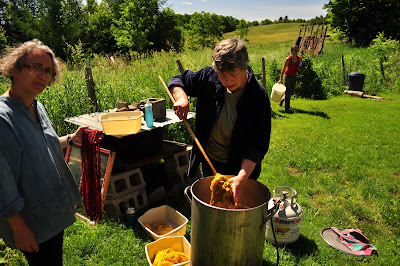 |
| we had great weather for the most part |
 |
| Barb weighs mordants while Tomi skeins up some cotton |
 |
| cutch vat underway with its chrome dip |
 |
| yarn to overdye in the indigo vat |
 |
| demonstrating the setup of the indigo vat |
 |
| Sylvia wringing out skeins |
 |
| black walnut extract and vinegar in the iron kettle |
 |
| overdyeing greens in the big indigo vat |
 |
| we set up a smaller indigo vat for blues |
 |
| Barb preparing yarrow for dyeing |
 |
| the iron kettle on the morning of Day 2 |
 |
| copper sulfate and logwood mixtures |
 |
| yarrow ready to boil |
 |
| Tomi checking skeins after the first stage of amish logwood purple |
 |
| cutch and yarrow vats - Day 2 |
 |
| Sylvia working skeins through the osage vat |
 |
| last stage of amish logwood purple |
 |
| end of Day 2 - making up the sample books |
 |
| cotton and linen samples drying at the end of Day 2 |
We had a great time dyeing yarn for twenty different colors during our annual Natural Dye Workshop for Cotton and Linen. Kate and I premordanted the samples that required a three-day alum-tannin-alum treatment to help save time, so after getting everyone's yarn skeins labeled and scoured, we set to work making up the remaining alum and tannin mordants for the simpler processes that could well be completed in two days.
Each student focused on preparing three or four dyes, from start to finish, although there was time during the day to check in on what other people were doing. Just a quick run-down of the dyes we worked with over the weekend:
Egyptian Purple
Amish Logwood Purple
Iron Buff
Black Walnut
Cutch Brown
Jet Black
Osage Orange
Brazilwood
Cochineal
Madder
Yarrow
Cinnamon
Madder Orange
Copperas Indigo Vat
Thiox Indigo Vat
Prussian Blue
Saxon's Green
Fustic Green
Olive Green
Many of these receipts call for an elaborate, multi-step procedure of mordanting, dyeing, fixing, airing, more mordanting, and overdyeing until they are complete. Logwood Purple and Jet Black are great examples of this; to obtain the rich deep traditional purple, the fiber is first mordanted with tannin overnight. The next day it is worked in the logwood vat, then aired, then alum and copper sulfate are added to the vat and the fiber is worked again, more logwood is added, then it is aired and rinsed out. It's pretty amazing to see the initial vibrant stages of deep orange turn into vivid purple. The Jet Black is similar and involves tannin, lime water, copperas, copper sulfate, logwood, fustic, madder, washing soda, and more copperas in a very precise sequence. I've never seen it a rich black, but it did go a very nice charcoal grey this year, which is better than I've seen it before.
We dye samples of cotton and linen yarn in each dye, so that each participant can have a record of each color and how it takes up with both fibers. In addition, students can bring some of their own yarn or cloth to experiment with, so they have some great natural dyed yarn to take home for a project.
By the end of the weekend we have a rainbow of lovely, subtle yarns hanging out on the line to dry in the sun and breeze. After clean-up everyone sits with the now-dried yarn samples and makes up a beautiful sample book to take home, which is a great review of the weekend's work, and a chance to really fix in one's mind just what all the colors look like.
It was a great class this year, with ample participation to make dyeing such a wide range of colors relatively easy. This course is a great general overview of the traditional receipts for natural dyeing. At the request of several participants, we are considering offering some more intensive work with mordanting and with single colors, so that each person has the opportunity to experience the full process. We may try this as more weekend courses or as an ongoing study group. We'll keep you posted as this develops.
No comments:
Post a Comment